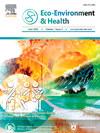Microplastics enhance the prevalence of antibiotic resistance genes in mariculture sediments by enriching host bacteria and promoting horizontal gene transfer
引用次数: 0
Abstract
Microplastics (MPs) and antibiotic resistance genes (ARGs) pose significant challenges to the One Health framework due to their intricate and multifaceted ecological and environmental impacts. However, the understanding of how MP properties influence ARG prevalence in mariculture sediments remains limited. Herein, the polystyrene (PS) and polyvinyl chloride (PVC) MPs with different sizes (20–120 μm and 0.5–2.0 mm) were selected to evaluate their impacts and underlying mechanisms driving ARGs dissemination. The results showed that PS and PVC MPs increased the relative abundance of ARGs by 1.41–2.50-fold and 2.01–2.84-fold, respectively, compared with control, particularly high-risk genes. The polymer type effect was identified as more influential than the size effect in driving the sediment resistome evolution. PVC shifted the microbial community assembly from stochastic to deterministic processes, thus enriching ARG host pathogens. Furthermore, the highly hydrophobic PS not only recruited the host bacteria colonization but also facilitated ARG exchange within the plastisphere. The exogenous additives released by PVC (e.g., heavy metals, bisphenol A, and tridecyl ester) and the particles synergistically promoted ARG conjugative transfer by inducing oxidative stress and enhancing cell membrane permeability. These findings revealed how MPs characteristics facilitated the spread of ARGs in marine benthic ecosystems, underscoring the importance of mitigating MPs pollution to maintain mariculture ecosystem health, prevent zoonotic diseases, and balance global mariculture with ecological health.

微塑料通过丰富宿主细菌和促进基因水平转移,增强了海水养殖沉积物中抗生素抗性基因的流行
微塑料(MPs)和抗生素耐药基因(ARGs)由于其复杂和多方面的生态和环境影响,对“同一个健康”框架构成了重大挑战。然而,MP特性如何影响海水养殖沉积物中ARG流行的理解仍然有限。本文选择不同尺寸(20 ~ 120 μm和0.5 ~ 2.0 mm)的聚苯乙烯(PS)和聚氯乙烯(PVC) MPs,研究了它们对ARGs扩散的影响和潜在机制。结果表明,PS和PVC MPs与对照相比,ARGs的相对丰度分别提高了1.41 ~ 2.50倍和2.01 ~ 2.84倍,特别是与高危基因相比。聚合物类型效应比粒径效应对沉积物抵抗体演化的影响更大。PVC将微生物群落组装从随机过程转变为确定性过程,从而丰富了ARG宿主病原体。此外,高疏水性PS不仅招募了宿主细菌的定植,而且促进了塑料圈内ARG的交换。PVC释放的外源添加剂(重金属、双酚A、三烷基酯等)和颗粒通过诱导氧化应激、增强细胞膜通透性等方式协同促进ARG共轭转移。这些发现揭示了MPs的特征如何促进ARGs在海洋底栖生态系统中的传播,强调了减轻MPs污染对维持海水养殖生态系统健康、预防人畜共患疾病以及平衡全球海水养殖与生态健康的重要性。
本文章由计算机程序翻译,如有差异,请以英文原文为准。
求助全文
约1分钟内获得全文
求助全文
来源期刊

Eco-Environment & Health
环境科学与生态学-生态、环境与健康
CiteScore
11.00
自引率
0.00%
发文量
18
审稿时长
22 days
期刊介绍:
Eco-Environment & Health (EEH) is an international and multidisciplinary peer-reviewed journal designed for publications on the frontiers of the ecology, environment and health as well as their related disciplines. EEH focuses on the concept of “One Health” to promote green and sustainable development, dealing with the interactions among ecology, environment and health, and the underlying mechanisms and interventions. Our mission is to be one of the most important flagship journals in the field of environmental health.
Scopes
EEH covers a variety of research areas, including but not limited to ecology and biodiversity conservation, environmental behaviors and bioprocesses of emerging contaminants, human exposure and health effects, and evaluation, management and regulation of environmental risks. The key topics of EEH include:
1) Ecology and Biodiversity Conservation
Biodiversity
Ecological restoration
Ecological safety
Protected area
2) Environmental and Biological Fate of Emerging Contaminants
Environmental behaviors
Environmental processes
Environmental microbiology
3) Human Exposure and Health Effects
Environmental toxicology
Environmental epidemiology
Environmental health risk
Food safety
4) Evaluation, Management and Regulation of Environmental Risks
Chemical safety
Environmental policy
Health policy
Health economics
Environmental remediation
 求助内容:
求助内容: 应助结果提醒方式:
应助结果提醒方式:


